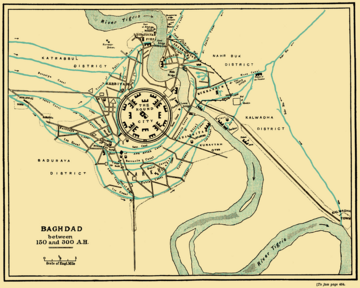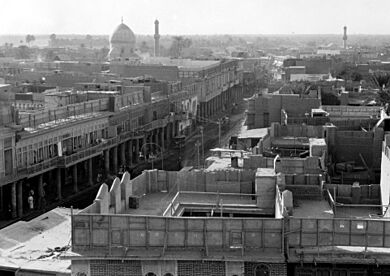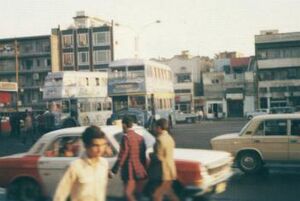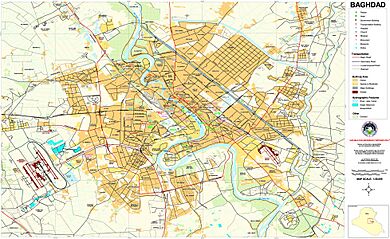History of Baghdad facts for kids
The city of Baghdad is the capital of Iraq. It was founded by the Abbasid dynasty in the 8th century. This marked a new beginning for Islamic history. Baghdad took the place of Seleucia-Ctesiphon, an older capital nearby.
Baghdad became the heart of the Caliphate during the Islamic Golden Age in the 9th and 10th centuries. It grew to be the biggest city in the world by the early 10th century. Later, it started to decline and was destroyed during the Mongolian invasion in 1258.
The city was rebuilt and grew again under Ilkhanid rule. However, it never reached its earlier greatness. Timur attacked it again in 1401. Then, it came under Turkic rule. Persia briefly controlled it in 1508. But the Ottoman Empire took over in 1534. After the dissolution of the Ottoman Empire, Baghdad was under British control in 1920. It became the capital of the independent Kingdom of Iraq in 1932. Later, in 1958, Iraq became a Republic.
Today, Baghdad is the capital of the modern Republic of Iraq. Its metropolitan area has about 7,000,000 people. These people live in neighborhoods across nine districts. It is the largest city in Iraq. It is also the second-largest city in the Arab world (after Cairo). And it is the second-largest city in West Asia (after Tehran).
Contents
Early History of Baghdad
Baghdad was founded on July 30, 762 CE. Caliph al-Mansur designed the city. An 11th-century scholar, Al-Khatib al-Baghdadi, wrote about its history. He said the city wall was 80 feet high. It had battlements and strong towers. A deep moat surrounded the outer wall.
Thousands of skilled workers helped build Baghdad. These included architects, engineers, and laborers. They came from all over the Abbasid Caliphate. One writer, Ya'qubi, thought 100,000 workers were involved.
Al-Khatib al-Baghdadi noted that no other round city was known in the world. Four gates were placed evenly around the outer walls. Straight roads led from these gates to the city's center. The Kufa Gate and Basra Gate connected to the Sarat canal. This canal was important for water flow from the Euphrates to the Tigris. The Sham (Syrian) Gate led to Syria. The Khorasan Gate was near the Tigris River. It led to a bridge of boats.
The four main roads had shops and markets. Smaller streets branched off these roads. They led to squares and houses. The space between the walls was limited. This was because Mansur wanted the city's heart to be a royal area.
By 766, Mansur's Round City was finished. A 9th-century writer, al-Jahiz, praised it. He said Baghdad was taller and more perfectly round than any other city he had seen. He also noted its spacious gates and strong defenses.
The city had many basic services. It employed civil servants. These included night watchmen and lamplighters. There were also health inspectors and market inspectors. A police force, led by a police chief, kept order. The police chief lived in the caliph's palace.
The City's Decline and Damage
The Round City was partly ruined during a siege in 812–813. Caliph al-Amin was killed during this time. His brother, Al-Ma'mun, became the new caliph. The city never fully recovered from this damage. Its walls were destroyed by 912. Today, nothing remains of them. Experts are not even sure exactly where the Round City was located.
Baghdad: A Center of Learning (8th to 9th centuries)
Caliph al-Mansur chose Baghdad's location carefully. It was a key spot on trade routes. It also had a mild climate and good land for defense. Plus, it was close to water. All these things helped the city become a center for culture and knowledge. Baghdad was on the Khurasan Road. This was a famous meeting point for trade caravans.
When the city was built, gates controlled traffic flow. The Kufah Gate was on a major road for pilgrims going to Mecca. The Anbar gate connected bridges over canals and the Euphrates River. These gates brought many people into the city. Markets near the entrances allowed travelers to trade. Being a hub for trade routes brought many goods to Baghdad. This made its markets popular throughout the Middle East.
Baghdad's markets were well-organized. The government watched over their products and trade. An advanced banking system also grew. This encouraged more people to settle there. Baghdad's location between the Tigris and Euphrates Rivers created trade links to places like China, India, and Armenia. This brought more people, books, and knowledge to the city.
The good climate and land also attracted travelers. Different cultures shared knowledge, books, languages, and beliefs. This created a "cosmopolitan city." It soon became a major learning center.
Many schools were built. These included the Hanafi and Hanbali schools of law. Studying law was very important for Muslim people. The Hanafi school is now the largest school of legal thought in the Muslim world. This drew many scholars to Baghdad. Another important school was the Bayt al-Hikma (House of Wisdom). This place focused on translating texts into Arabic. They translated texts from many different languages. This was needed to provide educated texts to a growing public. Translating Greek texts was especially important. It helped create a new way of thinking based on politics and science. This translation work also helped people move from an oral society to one based on written language.
Baghdad's location was perfect for making paper. This made books cheaper to produce. So, more books became available to more people. As more texts were made, new markets for book sellers opened. Libraries and bookstores appeared all over the city.
As more people became educated, new types of writing appeared. People wanted stories and entertainment. This shaped the culture of the city. It also influenced the entire Abbasid Empire. Baghdad was a key reason for the Golden Age of Islam. At this time, Baghdad was seen as the "center of the world" because of its learning. Michael Cooperson said that Baghdad's scholars were so many and so famous that they supported this idea. Al-Mansur also made sure that only the best scholars helped build the city. This further supported the idea of Baghdad as an intellectual city.
Al-Mansur originally built Baghdad as a military base. It could house and support many troops. A large army first made the city very populated. As the army needed supplies, more people came to Baghdad for jobs. This was another reason Baghdad became a center of trade. Baghdad also became the new capital of the Abbasid caliphate. This alone attracted many people. Al-Mansur appointed a governor for Baghdad. He also sent many important people there. This gave the city a higher status and attracted more scholars.
At its peak, Baghdad may have had over 1.5 million people. It might have been the largest city in the world at that time.
Challenges and Invasions (10th to 16th centuries)

By the 10th century, Baghdad's population was between 300,000 and 500,000. The city's fast growth slowed down. This was due to problems within the caliphate. The capital was moved to Samarra for some periods. Also, some western and eastern provinces were lost. For a time, Iranian groups like the Buwayhids (945–1055) and Seljuk Turks (1055–1135) controlled the city.
Still, Baghdad remained a major cultural and trade center in the Islamic world. But on February 10, 1258, the Mongols attacked it. Their leader was Hulagu Khan. The Mongols killed most of the city's people. This included the Abbasid Caliph Al-Musta'sim. They also destroyed large parts of the city. The canals and dykes that watered the city were ruined. The attack on Baghdad ended the Abbasid Caliphate. This was a huge blow to Islamic civilization. After capturing Baghdad, the Mongols put a Chinese governor in charge.
At this point, Baghdad was ruled by the Il-Khanids. They were part of the Mongolian Empire in Persia. The city was rebuilt and grew under the Mongols. In 1401, Timur (also known as Tamerlane) conquered Baghdad again. It then became a provincial capital. Different empires controlled it over the years. These included the Jalayirid (1400–1411), Qara Qoyunlu (1411–1469), Aq Quyunlu (1469–1508), and Safavid Persian (1508–1534, and 1624–1638) empires.
Ottoman Baghdad (16th to 19th centuries)
In 1534, the Ottoman Turks conquered Baghdad. Their leader was Suleiman the Magnificent. Shah Abbas I of the Safavids captured it in 1624. But the Ottomans, led by Murad IV, took it back in 1638. This happened during the Ottoman-Safavid War (1623-1639). Under the Ottomans, Baghdad went through a period of decline. This was partly because of the conflicts between the Ottomans and Safavid Persia. For a while, Baghdad had been the largest city in the Middle East. But Constantinople (now Istanbul) became larger in the 16th century. The city saw some growth again in the late 18th century. This was under the Mamluk dynasty. In 1907, Baghdad's population was about 185,000.
War Timeline
- Siege of Baghdad (812–813), during the Fourth Fitna (Islamic Civil War)
- Siege of Baghdad (865), during the Fifth Fitna
- Battle of Baghdad (946), Buyid–Hamdanid War
- Siege of Baghdad (1136), by the Seljuks
- Siege of Baghdad (1157), by the Seljuks
- Siege of Baghdad (1258), Mongol conquest of Baghdad
- Siege of Baghdad (1393), by Tamerlane
- Siege of Baghdad (1401), by Tamerlane
- Capture of Baghdad (1534), Ottoman–Safavid Wars
- Capture of Baghdad (1624), Ottoman–Safavid Wars
- Siege of Baghdad (1625), Ottoman–Safavid Wars
- Capture of Baghdad (1638), Ottoman–Safavid Wars
- Siege of Baghdad (1733), Ottoman-Persian Wars
- Fall of Baghdad (1917), World War I
- Battle of Baghdad (2003), United States invasion of Iraq
- Battle of Baghdad (2006–2008), Iraq War
Baghdad in the 20th and 21st Centuries
Baghdad remained under Ottoman control until World War I. On March 11, 1917, British forces captured it. After the war, Baghdad was placed under British control. During this time, the British built new buildings in the city. Iraq gained its independence from the British in 1932. It got more freedom in 1946.
On July 14, 1958, a revolution took place. The Iraqi king, Faisal II, was killed. The monarchy ended. Iraq became a republic. The city's population grew a lot. It went from about 145,000 in 1900 to 580,000 in 1950. In the 1970s, Baghdad became very wealthy and grew quickly. This was because the price of petroleum, Iraq's main export, went up a lot. New infrastructure was built. This included modern sewers, water systems, and highways.
However, the Iran–Iraq War in the 1980s was hard for the city. Money went to the army instead of the city. Thousands of people were killed. Iran launched some missile attacks on Baghdad. But these caused little damage or harm.
In 1991, the first Gulf War caused a lot of damage. Baghdad's transportation, power, and water systems were badly hit.
Baghdad was heavily bombed in March and April 2003. This was during the 2003 invasion of Iraq. The city came under US control by April 7–9. More damage happened due to severe looting after the war ended. After Saddam Hussein's government was removed, U.S. troops occupied the city. The Coalition Provisional Authority set up a "Green Zone" in the city center. This area was about three square miles (8 km2). They governed Iraq from there. This was before a new Iraqi government was formed. The Coalition Provisional Authority gave power to an interim government in June 2004.

On September 23, 2003, a Gallup poll showed that about two-thirds of Baghdad residents felt removing the Iraqi leader was worth the difficulties. They hoped for a better life in five years. But as time passed, support for the occupation dropped a lot. In April 2004, USA Today reported new poll results. Only 13 percent of people in Baghdad thought the invasion was morally right. This was much lower than in 2003.
Most Baghdad residents became impatient with the coalition forces. Basic services like electricity were still not reliable. This was more than a year after the invasion. In the summer of 2004, electricity was only available sometimes. Another big worry was the lack of safety. A curfew was put in place right after the invasion. It was lifted in late 2003. But the city, which once had a lively night life, was still too dangerous after dark for many. Dangers included kidnapping and getting caught in fights between security forces and insurgents.
On April 10, 2007, the United States military began building a wall. It was three miles (5 km) long and 3.5 meters tall. It was built around a Sunni district in Baghdad. On April 23, the Iraqi Prime Minister, Nouri Maliki, asked for the wall's construction to stop.
See also
- Timeline of Baghdad
- History of Iraq
- History of the Jews in Baghdad
- Iraq War






